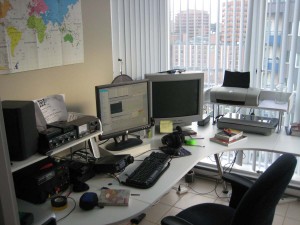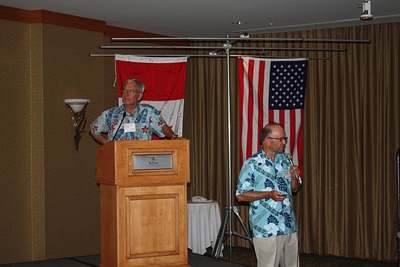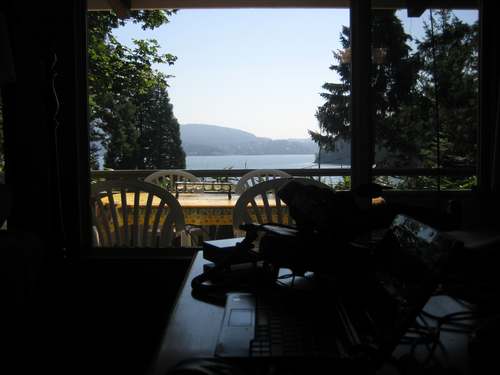
Shack!
Finally got around to installing a new desk from Ikea. Smartens up the shack a bit. Have few more things to do like finishing the install of ferrites on most leads plus I’m awaiting a delivery of filters from I.C.E. Radio.

Shack!
Finally got around to installing a new desk from Ikea. Smartens up the shack a bit. Have few more things to do like finishing the install of ferrites on most leads plus I’m awaiting a delivery of filters from I.C.E. Radio.
It was with great pleasure that I had the chance to operate at Paul W7IV’s station for this year’s CQ WW DX SSB Contest. We operated with Don’s N7BT call in the M/2 category. The team comprised Paul W7IV, Don N7BT, Dick N7RO, Phil VE7YBH, Dean KW7XX, Doyle KC7GX, Gary W7GLC and myself.
This was the biggest contest setup I have been involved with so far and it was an opportunity I could not pass up. Paul’s station is a few mile outside of Bellingham in Washington, just over the border from Vancouver. He has started to build a great station on his lot and already has three towers up with a fourth on the way as I speak.
The main station was an Elecraft K3, a new rig for me but one that I would appreciate immensely toward the end of the contest. Station two was an Icom Pro II, very familiar for me as I’ve honed my contest skills at VE7NSR on a Pro III. We ran 1.5kW on the main station with a Alpha 87a and 1kW from the second station with an Icom IC-PW1.
Another first for me was using WriteLog. I found it a little clunky at first and I missed the better designed bandmap and rate meters that N1MM has but am beginning to appreciate the text entry and editing capabilities.
Tower 1 has a SteppIR MonstIR Beam our main 20 & 40m antenna and a few meters above that, the pride of the station, an OptiBeam 80m 2 element yagi. Tower 2 was a SteppIR 4 element Yagi, this would become our main 10 & 15m beam.
I operated during the daylight hours alongside Paul, Don, Dick and Doyle, taking turns to operate or log. On Friday evening we went head first onto 15m hoping for a run of JA’s that never materialised. Conditions were not optimal and things only became tougher at night though Dean and Phil did manage a decent run of VK’s on 20m and JA’s later on 40m.
On Saturday morning I helped Phil finish his shift logging EU stations and then got a chance to run on the K3 toward Europe. 20m was choc-a-bloc, bloody nuts it was! I decided to start searching for mults and this proved fruitful, upping the scoring with the minimum of Qs. In fact I love searching and pouncing and after nearly two years of low power ops from the condo and VE7NSR I feel it is a skill I have honed well. I also love the K3’s sub receiver, having a second dedicated knob for it is really handy. While trying to bust one pile up you can be easily listening for the next mult.
After a break and some logging time it was back to operate station two on 15m on hopefully a run to Asia. Again the runs were in short supply so picking off the mults from the cluster was the way to go. With Doyle spotting new ones, we got every country and zone we could possibly get into Asia at that time on 15m. Tiring in the evening I gave Phil and Dean a hand as they started out on another tough night on the top bands.
The final day of any of 48hr contest always brings out a sense of urgency and it was no different this time round. From the get go I was in the seat on 20m to Europe getting a few runs here and there and at the same time trying to pick off a few more mults, highlight was 5Z4EE answering my call! Again the K3 is awesome for this, I can be calling on one freq and easily tuning around for new mults on the sub receiver.
For the runs it was a case of finding the minimum of space and just elbowing your way onto a frequency. There is no other way to put it, you need to push your way through the crowd and make room, nobody else going to do it for you. This was the coldest, hardest lesson I learned all weekend.
After lunch I sat and logged with Paul as he worked into Asia on 15m. At last we got the runs I felt we deserved. We worked simultaneously into South America as well, flipping the SteppIR 180 degrees as required, picking off some new zones and mults in the process. The JA’s woke up from their slumber and in the final three hours we clocked 60, 70 and 100 Qs each hour with the rate clock tipping well over 200/hr at times.
We also had VKs and ZLs calling from the side of the beam and worked numerous new mults including Cambodia and Vietnam. The logging was frenetic. Paul would CQ on one frequency and I would observe the spots, check if they were dupes or new mults in the log, stack a few up and pass him the frequencies. He’d line them up on VFO B, work’em and then flip back to the calling frequency. Those last few hours were lots of fun, even if I was only logging! I would happily do that for hours on end if the runs are good.
Highlight of the afternoon was spotting V6B in Micronesia on the cluster. We were working South America at the time, hit 180 on the SteppIR and worked him first time, busting the pile-up as all the ‘big’ east coast continued to struggle…….we had a good chuckle about that one!
Though the guys would admit they had set their sights a little higher we still turned out a good performance for a non-big gun station. Thanks to all the guys for a fun weekend, hopefully the first of many.
Claimed Score (as submitted to 3830):
Summary: Band QSOs Zones Countries ------------------------------ 160: 28 4 3 80: 137 23 35 40: 463 29 63 20: 573 35 106 15: 650 30 88 10: 96 10 16 ------------------------------ Total: 1947 131 311 Total Score = 2,259,062 -------------------------------------------------------- -
This month sees the launch of the Orca DX and Contest Club.With a focus on BC and northwestern Washington, the club is open to all licensed amateurs who share a passion for DXing and contesting.
The Orca DX and Contest Club (Orca DXCC) was established in Fall 2010 to serve as a community open to all amateur radio operators in BC or the BC-Washington border region with an interest in DXing and contesting.
We share unique opportunities and challenges in “working the world” from the top-left corner of North America. The Orca DXCC brings together active radio operators to share their experiences, and provide encouragement and mentoring to all who strive to one day “work ’em all” from here.
Please visit the club site at orcadxcc.org to get all the latest news and membership information.
This years Pacific Northwest DX Convention was held in Burnaby just outside of Vancouver, presenting a great opportunity to meet new people and hear some great ideas. The agenda was packed with a variety of talks and presentations spread over a weekend at the end of July. I had initially written a really, really long article on the Convention but felt I couldn’t do justice to each and every presentation so I’ve decided to give a brief overview on the presentations that really stood out to me.
Early on the Saturday morning after an interesting insight into the IARU, Karl KL9A, gave us his propagation predictions. I’m an avid reader of Karl’s column in the National Contest Journal (NCJ) and looked forward to his presentation here. Karl’s articles always strike a great balance between knowledgeable and lively writing and his presentation at the convention was no different. So what are those sunspots doing?
Well, they’ve been here long before civilisation and will probably outlast civilisation, there will always be sunspots, just not always in the numbers we would like! Not only is there the regular 11 year Schwabe ‘solar cycle’ but Karl also described the various other cycles of Hale, Gleissberg, Suess and Halstatt, showing solar activity patterns over hundreds and thousands of years.

Pacific Northwest DX Convention 2010 attendees
Predictions put Cycle 24 in the ‘weak’ category with a peak mean daily sunspot count of 90 in 2013. Considering that less than two years ago we regularly had 25 or more sunspotless days in a row, then I am not going to be complaining about a ‘weak’ daily mean of 90 sunspots!
In the afternnoon we had a standout show from Don VE6JY and Mitch VE6OH about Don’s superstation in Alberta. The guys really wowed the crowd with their tales of construction and destruction! With 27 towers on site, VE6JY’s antenna’s are subject to the harsh rigours of Canadian winters.
What impressed me the most about the VE6JY station were the multitude of monobanders all constructed on site. Other than the radios themselves everything at the station is either created or recycled from scrap and auctioned items, including their crane. Yes, to make servicing the 4 element 80m monobander that much easier Don purchased a wheeled crane at auction! You can read that great presentation here on his site.
The final presentation that afternoon came from Ward Silver, NØAX. Ward is a writer and regular contributor to QST and NCJ. He is also involved in editing the ARRL Handbook and also wrote the Ham Radio for Dummies book. His informative presentation not only covered issues relating to contesting but also education. In his role as educational writer, Ward was particularly interested in the challenges in writing for hams of varying technical abilities and backgrounds. He also hoped that advances in real time contest scoring would bring a new breed of younger hams to contesting.

Bill N7OU and Bob W7YAQ discuss Tokelau
After dinner and a photo tour of ARRL HQ we had the presentation that I had been waiting all day for. Bill N7OU and Bob’s W7YAQ excellent adventure to Samoa and Tokelau. I won’t go into too much detail, as they’ve presented this trip numerous times and it also the subject of a great article in this month’s QST, however this DXpedition featured everything including remote atolls, tsunamis, ever friendly locals, cold beers and of course thousands of QSOs!
As I’ve said before I love the adventure that comes with small DXpeditions. There is a certain gung-ho attitude amongst dxers of this breed because compared to the big multinational dxpeditions these little adventures have less at stake. When things go wrong smaller dxpeditions are more flexible to change as was the case for Bill and Bob when they were stuck in Samoa for a number weeks. Of course smaller dxpeditions can’t get to the real hardcore DX entities, but with the smaller operations, getting to that remote island or atoll is more than half the adventure!
Other highlights from the convention included K7BV Dennis’ 6m adventure to San Andres Island and K9JF Jim’s travelogue about the ever popular Friedrichshafen hamfest in Germany.
As a newcomer to the hobby it was very enjoyable to meet in person all those ops I have worked numerous times in contests in the past year and half. At last I can put some faces and great personalities to those ever familiar callsigns. Conventions like these are a great reminder that the world of amateur radio doesn’t end outside our shack door.
What a great time I had on Bowen, awesome in just one word. I think I’m going to move there!
We had rented a nice cabin for a few days and luckily enough it fell around the dates of the IOTA contest ( hi hi ). I had been eying up a 12m Spiderbeam spiderpole as a means of supporting temporary antennas, so I took the plunge and purchased one a few weeks before the trip. I also pruchased the 1 element quad kit and figured with the AH-4 coupler I could tune up the 20m quad 80m thru 6m.

Spiderpole 20m 1 element quad
The week before the trip out to Bowen I ventured out to Jericho beach here in Vancouver while the YL was rowing. I brought along the spiderpole and my Icom IC-R1500 receiver. I decided not to extend all the sections as I had not brought along guys so I just used half the antenna, 6 sections, 20ft. With a simple 3/4 inch 2ft pvc pipe in the sand as a support, the 6 sections stood up ok without guying. The bottom six sections also stood up without guying by using a 2 inch 3ft ABS pipe halfway in the sand. The plan on Bowen depending on soil type was to use 3 medium sized bamboo poles driven about 1ft into the ground, a 1.5 ft length of ABS pipe would be placed over these and the spiderpole placed over the pipe. This would stop the base kicking out as I extend the pole which would be guyed further up.
Packing the gear became a bit of a military operation, I felt like Santa Claus ticking off his lists! I wasn’t totally aware of the layout of the property so I made sure to bring plenty of extra coax, window line and 4 conductor cable for the coupler. As usual I try to pack light. All the gear fitted in two bags. The rig, laptop and accessories went in the LowePro which I had brought to Ireland before and the coax, tuner and spiderpoles went into a photographic stand bag I had sequestered from the YL! For future long distance DXpeditions I will look at golf hardcases to carry the spiderpole.
When we arrived at the cabin I was a wee bit surprised. I had surveyed the site on google earth and on the Bowen Island municipality website which showed property lines. I had got the impression that the backyard was a bigger. Well actually the backyard was big, except most of it was a sloping wooded creek which wasn’t apparent from either the topo maps or google earth! Oh dear! Off to the pub. Yes you see, this was a holiday style dx event and there is nothing better to refresh the mind than a few pints and fish and chips. The contest would start in the morning and I decided to leave the erecting till then.

Working the non-existent pile-ups!
Up at 5am and straight to work. I surveyed the site, 10ftx40ft and decided I could probably erect the quad but only while it is upright. Normally you would probably assemble the complete quad on the ground and hoist it all up. I didn’t have the room, so I would have to raise it section by section. After about 3 hrs it was up, the problem…..guying. Spiderbeam offer you one guy ring for the 12m pole. However this guy ring sits inside the quad at the 7m level, making it un-rotatable. I improvised a set of guys just below the quad feed point at about 4m height. This wasn’t sturdy enough so I added a second set at about the 2m level. Spiderbeam really need to offer another guy kit for those who purchase the quad kit, I might drop them an email.
Bowen is IOTA NA-091, British Columbia South Group. Sometimes incorrectly lumped in with the Gulf Island group NA-075 I was hoping NA-091 would attract a decent amount of QSOs during the contest……….not a chance. Conditions were poor for SSB, really poor, even W6 stations were fading up and down on 20m in the morning hours. Lets just forget about the contest, I didn’t even break the hundred mark! The quad did tune up well on 40m though and even at just 40ft, Brazil, Argentina and Australia where all easily worked on phone with 100w. Europe was not heard at all, a consequence of being surrounded by mountains on the north side of Bowen and on the mainland to the northeast, the lowest usable takeoff angle to Europe from this QTH was probably about 40 degrees, which is far too high!!!
Throughout the week I casually got on the air, mainly in SSB but also the odd time on PSK. After the disappointing show on Saturday I took a break for a day and enjoyed a day on the beach instead. Monday morning was fun though as somebody had spotted me on the cluster and I worked a string of dedicated US island hunters whose QSLs I already have in my hand, thank you very much! At the end of the week I took down the quad on the spiderpole and erected the antenna as a 20m rectangular loop on the cabin deck. Using the 4m quad cross supports as vertical supports for a 4x6x4x6m loop, it worked pretty well and was much easier to put up and down.

What a view from the 'shack'!
To surmise, Bowen was a good exercise, a really good exercise. Getting familiar with the spiderpole was the most important exercise as I have a few dxpeditions planned in the back of my head that I really want to pursue. The guys who did Mellish (vk9gmw) and Chesterfield (tx3a) really impress me, two or three guys, simple wire antennas and a focus on specific bands. These low-key, lo-fi dxpeditions are the ones that interest me the most, maybe one day I will be working you from a dxpedition like this!